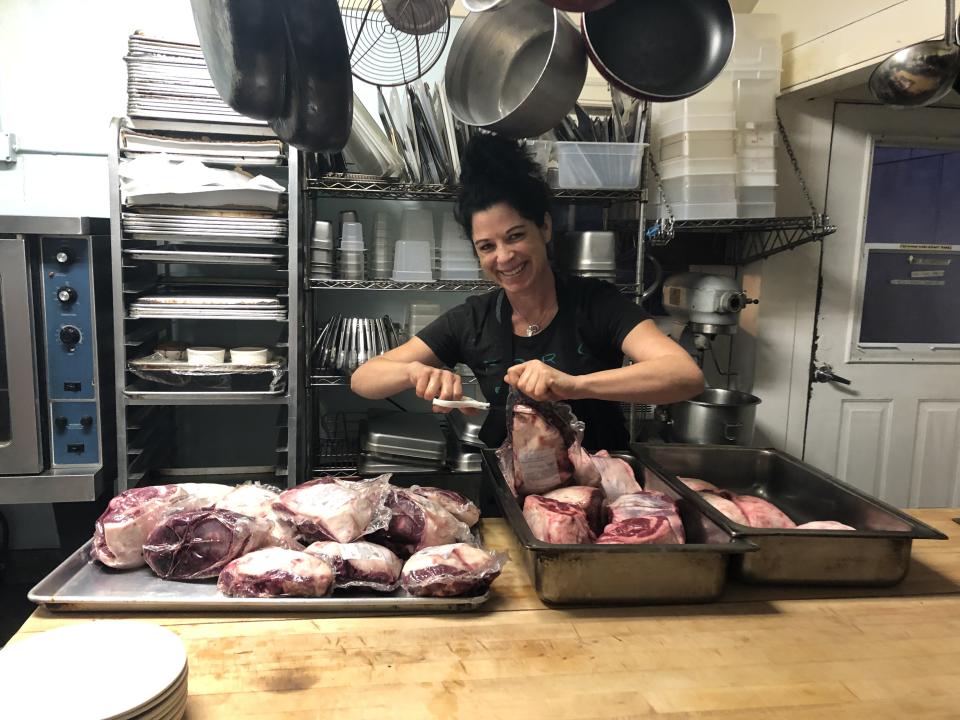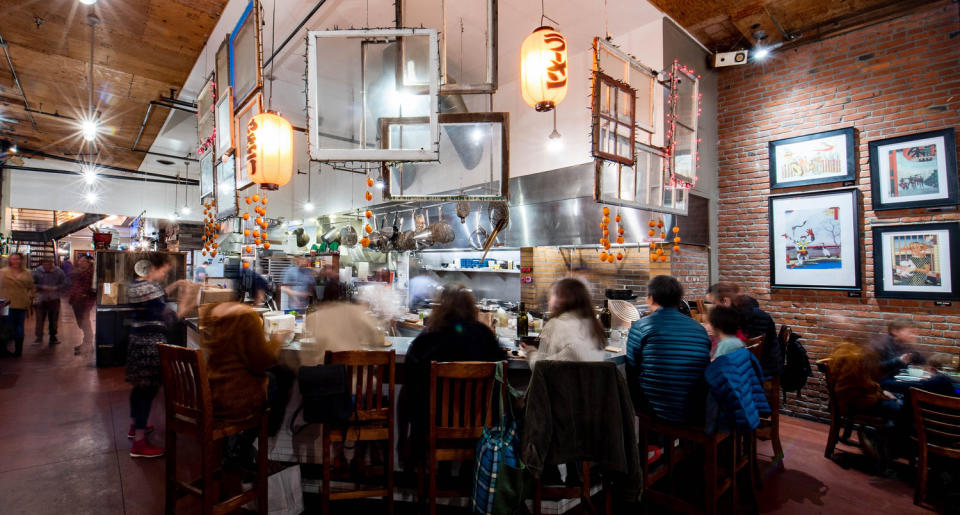Sonoma County chefs grapple with 'new reality' of doing business amid wildfires
Sonoma County is synonymous with farm to table dining and wining. And the fires across California have created irreparable damage in the region.
At their peak last week, there were as many as 16 wildfires across the state. The Kincade fire in Sonoma County was the largest in magnitude, burning around 78,000 acres, or double the size of San Francisco, since it first started on Oct. 23. While it is now 84% contained and all evacuations have been lifted, small businesses say it’s a long road to recovery.
Sarah Piccolo, the owner of farm-to-table restaurant Fork Roadhouse in downtown Sebastopol, lost her power for five-and-a-half days. Also operating a catering business, Piccolo said two big events scheduled for last weekend were canceled because of road closures and power outages.

‘We are sitting on a lot of wasted food’
Though the events are being rescheduled, that was $30,000 of business she isn’t getting right away. Her restaurant, which serves breakfast, lunch and dinner, was also closed for the week. Without power, dirty dishes sat in the sink and food, like 50 pounds of short rib, was either tossed or donated. And she was unable to pay any of her 18 employees.
She reopened the restaurant with a limited menu on Friday. When power is restored, websites are updated and phone lines are reconnected, it still takes two to three days for business to feel steady again.
Ramen Gaijin, another Sebastopol establishment, also reopened with a bare bones menu after six days of no power. Matthew Williams, the chef-owner of the popular ramen and izakaya spot, saw a lower volume of reservations for the weekend the fires started blazing.
“We called off service, but I stayed downtown to tighten things up and shut off the gas. We originally had 190 on the books, but we usually have around 300 on Saturday nights,” he told Yahoo Finance.
While Sonoma County boasts idyllic wineries and landscapes, rolling hills and charming town squares, the cost of doing business has become utterly overwhelming. Restaurants across Sonoma County lost an average of $4,700 during PG&E’s three-day power outage earlier in October, according to a Sonoma tourism board poll.
Williams said it’s the first time he believes it would be the best financial decision for Ramen Gaijin to invest $20,000 to install generators in the 6,000 square foot building. He estimates that the business lost $50,000 in sales during the course of the week and $5,000 worth of product. The restaurant makes its own dumplings in house and even pays a person to handle noodle production.
“We were sitting on a lot of wasted food. We lost 90, 100 pounds of our wagyu beef, pork belly and char siu. We’re always three days ahead because the long process to cure and braise it,” he said.

Where does the food go?
While Sonoma County chefs aren’t able to open up their restaurants during the power outages, they are able to salvage some of their produce, dairy, and meats.
Sonoma Family Meal is a grassroots organization that works exclusively with local purveyors and restaurants looking to donate their valuable and perishable ingredients.
Founded by Heather Irwin, who is a food columnist for Bay Area newspaper The Press Democrat, Sonoma Family Meal whips up gourmet meals like smoked brisket, shepherd’s pie, fresh bread from local bakeries, polenta and mushroom ragout, bacon quiche, roasted squash gratin, chocolate bread pudding, even porterhouse steaks to families in need.
This was Irwin’s response to the fires in 2017 when she witnessed the community scraping by on cold pizza. She found that there was plenty of supply during these crises to meet the demand of local residents.
On a much larger scale, celebrity chef and restaurateur José Ramón Andrés started the nonprofit organization World Central Kitchen in 2010, with a goal to provide food during natural disasters.
Irwin, who takes off vacation time to work on this nonprofit on the side, only recently hired a full-time executive chef to run the organization. Her 15 years writing about food connected her to chefs in the area, who have helped with meal prep and service. Together they have served 200,000 to-go meals over the last two years, with over 10,000 half-sheet pans distributed over the last week.
“We already know we’ll be operating through the end of December, early next year. People are in need. Hundreds if not thousands of restaurant workers are not getting wages right now,” she said. Of course, the financial strain doesn’t vanish once the power returns. Sonoma Family Meal started a program called “Fill Your Fridge” for those who can’t afford to stock up on the essentials.
On a broader level, Irwin wants to help the community at least check one thing off their to-do lists. “People are experiencing PTSD. Moms and dads are completely overwhelmed by the insurance process, taking kids to different schools, who have evacuated to different places. We’re a support system not just if you’re in financial need, but also for families experiencing long-term trauma,” she said.
Impact on tourism
The livelihood of Northern California is heavily dependent on tourism, which has taken a hit over the last few years. Sonoma County’s hotel occupancy rates are down 4% since last year.
In 2017, wildfires engulfed more than 1.5 million acres, killing 44 people and burning more than 11,000 structures. Last year, more than 1.6 million acres were burned, with nearly 25,000 damaged or destroyed structures. Last year’s Camp Fire was the deadliest in the state’s history.
The unrelenting visuals and coverage of burning flames ravaging Northern California are turning potential visitors away from Sonoma County, according to Irwin.
“Restaurants have not bounced back. Most have had a miserable two years. We’ve lost tourism, people are really having a tough time affording rents and rebuilding homes,” she said.
Anyone who has been to Sonoma County understands that small businesses are the engine of the economy. Seventy-six percent of the region’s tourism businesses have fewer than 25 employees and 91% are locally owned, with only 8% of those a franchise.
Williams said he can feel the decline in tourism, and while he’s up on the year in sales, it’s because of menu price increases he implemented.
Still, despite the tempestuous conditions, Sonoma County still sees 10.8 million visitors annually, and chefs can’t imagine leaving the area to set up shop elsewhere.
“We’re certainly trying to figure out what the steps are to be able to maintain the business in a profitable manner, because this is the new reality,” Williams said.
While on the phone with Yahoo Finance on Friday afternoon, Piccolo’s power came back on, and she exclaimed effusively, “Oh, looks like the power is back! I’m just happy to be back in business. We’re looking on the bright side.”
Melody Hahm is a senior correspondent at Yahoo Finance, covering entrepreneurship, technology and culture. Follow her on Twitter @melodyhahm.
Read more:

